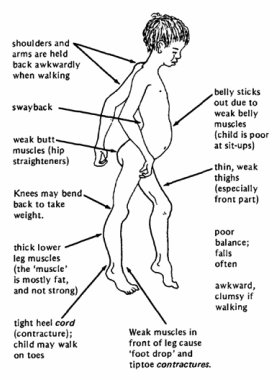How do I know if my child has DMD? There are a number of early common signs displayed by children with DMD. Symptoms usually appear before the age of 6 and often appear as early as infancy. If a boy has a combination of the traits listed below he should be considered for DMD testing. Muscle wasting generally occurs at the lower muscles first (eg calves, pelvis, thighs and hips) but then may progress to the arms, neck, as well as other regions of the body. As the disease progresses, bones may develop abnormally, causing skeletal deformities of the spine and other areas |  Figure 5: Physical Characteristics
|
The resultant musculoskeletal abnormalities result in distinguishable physical characteristics which can be seen above.
- Larger than normal calves (pseudohypertrophy)
- Shoulders held back awkwardly during walking
- Foot dropped
- Sway back with belly sticking out.
Muscle wasting causes difficulty with a lot of movements. For example:
-
Delayed motor milestones (eg is not walking by 15 months)
- Needs help standing from the floor or uses his hands to “walk up” own body to stand upright. (Gower’s manoeuvre – see video below)
- Awkward walking patterns tending to walk on forefeet with the butt and stomach sticking out, and shoulders rolled back. The ability to walk often becomes progressively more difficult and may be completely lost by 12 years of age.
-
Difficulty running and climbing.
- Frequent falls.
- Often perceived as clumsy or lazy
- Increased levels of fatigue and the inability to sustain activity for long periods of time
Children with DMD may also be at higher risk of learning difficulties and behavioural problems.
Video 1: Clinical signs of DMD including calf pseudohypertrophy and Gower's sign
